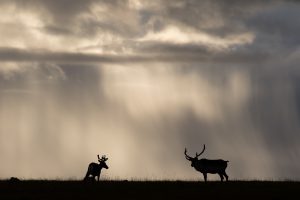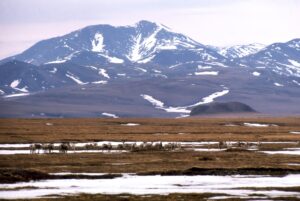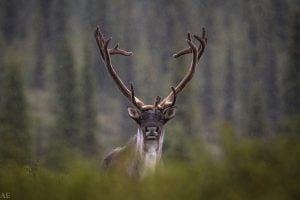It’s springtime in the north. Snow is melting, rivers are breaking up, and barren-ground caribou are on the move. Each spring, the Qamanirjuaq herd walks hundreds of kilometres from the boreal forest to their calving grounds in Nunavut’s Kivalliq region, arriving with the spring green-up. The caribou feast on this first flush of tender, nutrient-rich plant growth. But as climate change heats the north, this green-up is happening earlier in the year.
Dr. Conor Mallory says the environmental change is expected. The Nunavut government biologist is the lead author of a new University of Alberta study published in Oecologia on the caribou’s response to that change.
“We’re seeing the caribou respond to that by advancing their migratory and reproductive behaviour.”
The herd has sustained northern communities for thousands of years. With caribou numbers plummeting across Canada, researchers wondered whether a phenomenon called “trophic mismatch” is responsible. Many species have evolved to match their life cycles to food availability. If climate change pushes those cycles out of sync, the trophic mismatch can leave animals hungry. Mallory says researchers have debated whether the phenomenon poses a danger for caribou. Some biologists think caribou, who gestate calves through the winter, are less susceptible to this than smaller migratory species like birds, who need spring food to fuel their nesting season.
Using data from GPS-collared cows in the Qamanirjuaq herd, researchers compared the timing of migration and birth with snow cover and green-up from 2004 to 2016 and did not find a trophic mismatch. While green-up is happening a week earlier on the calving grounds, calving is nine days earlier too. Caribou are starting their spring migration two weeks earlier, and arriving at the calving grounds a week earlier than before.
“The actual time taken to migrate appears to have increased. So they’re migrating more slowly, as the climate warms,” says Mallory. The longer migration is likely due to changing snow conditions on the herd’s winter range and declining snow cover along their route. Trudging through slushy or soft snow takes extra energy, and falling through the spring ice crust can injure the animal’s legs.
Researchers still have more to learn. The recent study is “an interesting piece of the puzzle,” but not the full picture, says Mallory. GPS data doesn’t show what condition the caribou are in when they reach their calving ground, so checking on the health of cows and calves would be a good next step for research, he says.
A very bad time for caribou
The Qamanirjuaq herd ranges from Nunavut to the Northwest Territories, Manitoba and Saskatchewan. Inuit, Dene, Cree and Métis communities rely on the herd for high-quality meat straight from the land. A 2013 report valued the annual harvest of the Qamanirjuaq herd at $15 million.
The herd has declined from nearly 500,000 animals in 1994 to 344,000 in 2008 and 288,000 in 2017. The Beverly and Qamanirjuaq Caribou Management Board (BQCMB) says the herd is stable, but rates its vulnerability as medium to high. The board fears that if the herd gets any smaller, it will no longer be able to sustainably feed the people who harvest it.
“If that source of traditional, high-protein, valuable meat and livelihood was not available, it would have to be supplemented from elsewhere,” says biologist Ross Thompson, the board’s executive director. “It’s very, very important as a cultural, economic and traditional value to Indigenous people.”
Like almost every caribou herd in Canada, the herd is threatened by a combination of factors. Climate change, disturbance, habitat loss, harvest, disease, and predation all add up. “It is a very bad time for caribou all across the Arctic,” says Thompson.
Dr. Mark Boyce, another author of the University of Alberta study, says researchers don’t yet fully understand how each factor affects the caribou, but says winter range is likely a crucial factor.






